| Battle of Sirhind (1555) | |||||||
|---|---|---|---|---|---|---|---|
| Part of Delhi | |||||||
| |||||||
| Belligerents | |||||||
| | Suri Empire | ||||||
| Commanders and leaders | |||||||
| | Sikandar Shah Suri | ||||||
| Strength | |||||||
| 50,000 [1] | 90,000 [2] | ||||||
The Battle of Sirhind was fought between the Mughal Empire and the Suri Empire in 1555.
| Battle of Sirhind (1555) | |||||||
|---|---|---|---|---|---|---|---|
| Part of Delhi | |||||||
| |||||||
| Belligerents | |||||||
| | Suri Empire | ||||||
| Commanders and leaders | |||||||
| | Sikandar Shah Suri | ||||||
| Strength | |||||||
| 50,000 [1] | 90,000 [2] | ||||||
The Battle of Sirhind was fought between the Mughal Empire and the Suri Empire in 1555.
Humayun had been in exile for 15 years after being forced to flee by Sher Shah Suri, a Pashtun commander who had taken control of the Mughal territories. During his exile, Humayun spent time in Persia where he was exposed to Persian high culture and military technology. This exposure gave him valuable insight into administration, politics, and warfare, which would later serve him well in his quest to reclaim his empire. After defeating his brothers in Afghanistan and Uzbekistan, Humayun was able to solidify his hold over the region and return to India, where he successfully recaptured Babur's former capital of Delhi and reestablished the Mughal Empire. [3]
After the death of Islam Shah Suri, the Suri Empire had erupted in a civil war where various contenders to the throne fought each other for supremacy. Sikandar Shah Suri was occupied with his struggle against Ibrahim Shah Suri when Humayun mobilized an army from Kabul. He captured Rohtas Fort and Lahore in February 1555. Another detachment of his forces captured Dipalpur, Gurdaspur and Jalandhar. Their advanced division proceeded towards Sirhind. Sikandar sent a force of 30,000 to intercept them but they were defeated by the Mughal Army in the Battle of Machhiwara and Sirhind was occupied by the Mughals. [4]
Sikandar led an army of 90,000 and met the Mughals at Sirhind. [5] On 22 June 1555 they met in battle. Humayun and Bairam Khan carried out a daring raid in a rainstorm like Sher Shah Suri had done at the Battle of Chausa to defeat Humayun. [6] Sikander was defeated by the Mughal Army and was compelled to retreat to the Sivalik Hills in northeastern Punjab. [7] The victorious Mughals marched to Delhi, occupied it and reestablished their empire in India. [5]
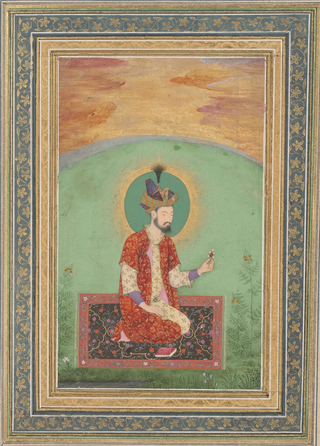
Nasir al-Din Muhammad commonly known by his regnal name Humayun, was the second Mughal emperor, who ruled over territory in what is now Eastern Afghanistan, Bangladesh, Northern India, and Pakistan from 1530 to 1540 and again from 1555 to his death in 1556. At the time of his death, the Mughal Empire spanned almost one million square kilometers.

The Second Battle of Panipat was fought on 5 November 1556, between Akbar and the king of Delhi, Hemu. Hemu had conquered Delhi and Agra a few weeks earlier by defeating Mughal forces under Tardi Beg Khan in the battle of Delhi and crowned himself Raja Vikramaditya at Purana Quila in Delhi.

Sher Shah Suri, often referred to as Sultan Adil, was the founder of the Sur Empire in India. He was the regent and later sole ruler of Bihar from 1529—1540 until he defeated the Mughal Empire in 1540, founding the Sur Empire, and establishing his rule in Delhi, crowning himself as Emperor. After his accidental death in 1545 CE, his son Islam Shah became his successor. The influence of his innovations and reforms extended far beyond his brief reign. In his reign, he remained undefeated in battle, being renowned as one of the most skillful Afghan generals ever produced.

Mandu or Mandavgad is an ancient city in the present-day Mandav area of the Dhar district. It is located in the Malwa and Nimar region of western Madhya Pradesh, India, at 35 km from Dhar city. In the 11th century, Mandu was the sub division of the Tarangagadh or Taranga kingdom. This fortress town on a rocky outcrop about 100 km (62 mi) from Indore is celebrated for its architecture.
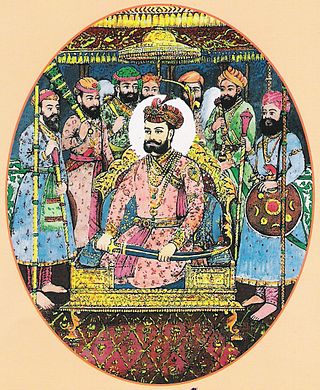
Hemu was an Indian emperor who previously served as a general and Wazir of Adil Shah Suri of Sur Empire during a period in Indian history when Mughals and Afghans were vying for power across North India. He fought Afghan rebels across North India from Punjab to Bengal and Mughal forces of Humayun and Akbar in Agra and Delhi, winning 22 battles for Adil Shah Suri.
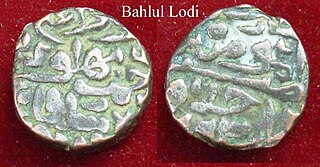
Bahlul Khan Lodi was the chief of the Afghan Lodi tribe. Founder of the Lodi dynasty from the Delhi Sultanate upon the abdication of the last claimant from the previous Sayyid rule. Bahlul became sultan of the dynasty on 19 April 1451.

Muhammad Bairam Khan, commonly known as Bairam Khan or Bayram Khan was an important military commander, and later commander-in-chief of the Mughal army, a powerful statesman and regent at the court of the Mughal Emperors, Humayun and Akbar. He was also the guardian, chief mentor, adviser, teacher and the most trusted ally of Akbar. Akbar honoured him as Khan-i-Khanan, which means "King of Kings". Bairam was originally called Bairam "Beg", but later became honoured as Khan. Bairam Khan was an aggressive general who was determined to restore Mughal authority in India.
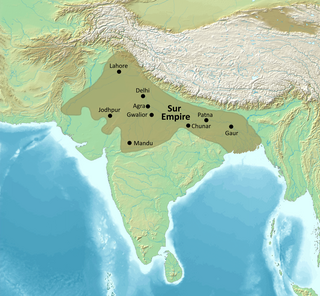
The Sur Empire was an empire ruled by the Afghan-origin Sur dynasty in northern India for nearly 16 or 18 years, between 1538/1540 and 1556, with Sasaram serving as its capital. It was founded by Sher Shah Suri.
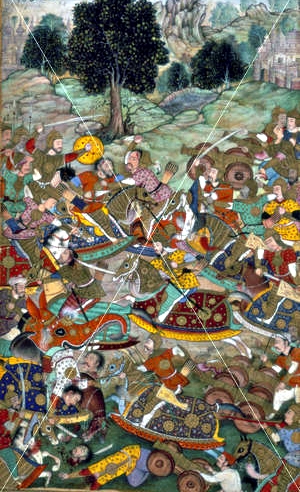
The Battle of Khanwa was fought at Khanwa on March 16, 1527. It was fought between the invading Timurid forces of Babur and the Rajput Confederation led by Rana Sanga for supremacy of Northern India. The battle was a major event in Medieval Indian history although Timurids won at Panipat but at the time, the sultanate at Delhi was a spent force that was long crumbling. To the contrary Mewar kingdom, under the able rule of Rana Sanga, had turned into one of the strongest powers of northern India. Therefore, the battle was among the most decisive battles in the Mughal conquest of northern India. It was among the earliest battles in Northern India where gunpowder was used to a great extent. The battle resulted in heavy casualties for both Timurids and Rajputs. Babur is said to have created a Pyramid with the heads of the Rajputs after the triumph in the battle.

Adham Khan was a general of Akbar. He was the younger son of Maham Anga, and thus, was the foster brother of Akbar. In his fourth regnal year, Akbar married him to Javeda Begum, the daughter of Baqi Khan Baqlani.

Rao Maldeo Rathore was a king of the Rathore dynasty, who ruled the kingdom of Marwar in present day state of Rajasthan. Maldeo ascended the throne in 1531 CE, inheriting a small ancestral principality of Rathore's but after a long period of military actions against his neighbours, Maldeo swept significant territories which included parts of present day Rajasthan, Haryana, Uttar Pradesh, Gujarat and Sindh. He refused to ally with either the Sur Empire or the Mughal Empire.

Muhammad Adil Shah was the fourth ruler of the Suri dynasty, a late medieval Afghan dynasty in the northern Indian subcontinent.

Sikandar Shah Suri was the sixth ruler of the Sur Empire, a late medieval Pashtun dynasty of northern India. He became the sultan of Delhi after overthrowing Ibrahim Shah Suri.

Ibrahim Shah Suri was the fifth ruler of the Sur dynasty, a Pashtun (Afghan) dynasty of late medieval northern India.

Adil Shah Suri was the seventh and final ruler of the Sur Empire. He was the brother in law of Sikandar Shah Suri, who ruled over a region east of Delhi after Sikandar Shah Suri was defeated by Humayun in 1555. He and Sikandar Shah Suri were contenders for the Delhi throne against the Mughal emperor Akbar.

The Malwa Sultanate was a late medieval kingdom in the Malwa region, covering the present day Indian states of Madhya Pradesh and south-eastern Rajasthan from 1401 to 1562. It was founded by Dilawar Khan, who following Timur's invasion and the disintegration of the Delhi Sultanate, in 1401, made Malwa an independent realm.

The Gujarat Sultanate or Sultanate of Guzerat was a late medieval Indian kingdom in Western India, primarily in the present-day state of Gujarat. The kingdom was established in 1394 when Muzaffar Shah I, the Governor of Gujarat, declared independence from the Tughlaq dynasty of Delhi.
The Battle of Sammel, also known as the Battle of Giri-Sumel, took place in 1544. It was fought near the villages of Giri and Sumel, between the Afghan Sur Dynasty under Sher Shah Suri and the Rathore army led by the commanders Jaita and Kumpa of Rao Maldeo Rathore.
The Battle of Machhiwarra was fought between Mughal Empire and Suri Empire in 1555.